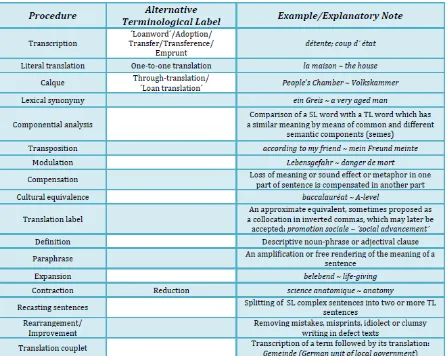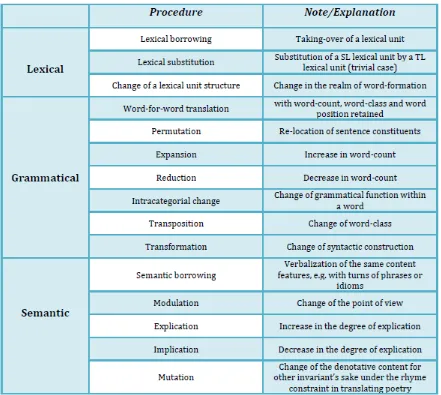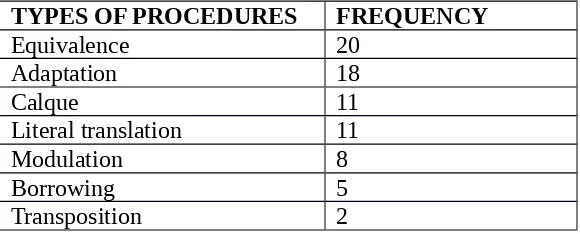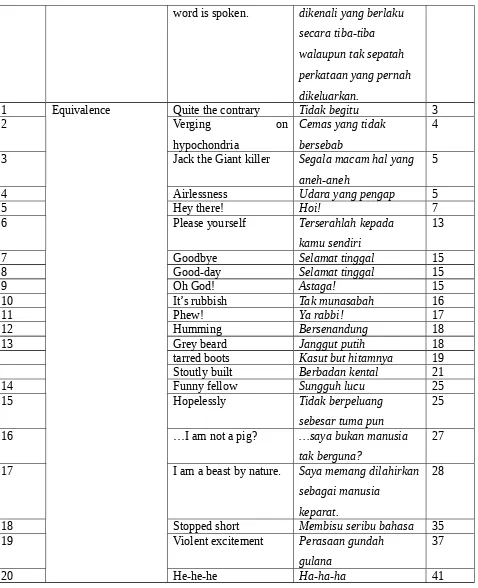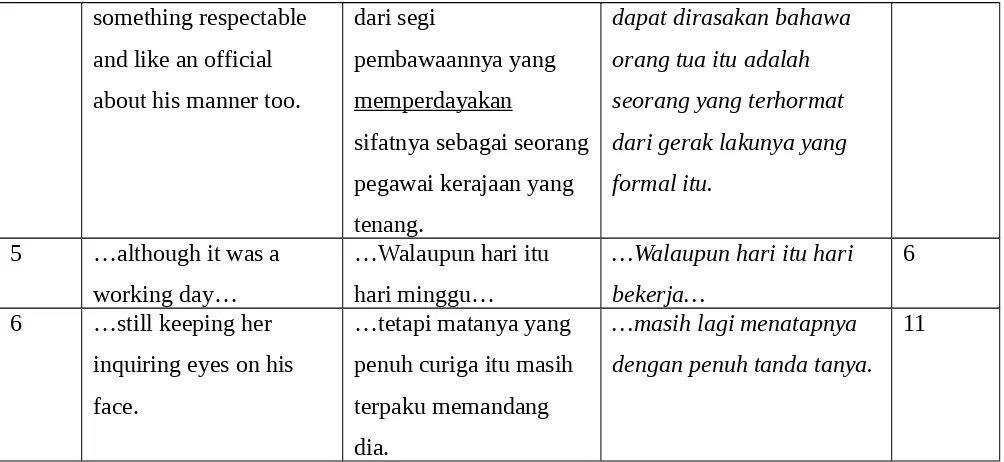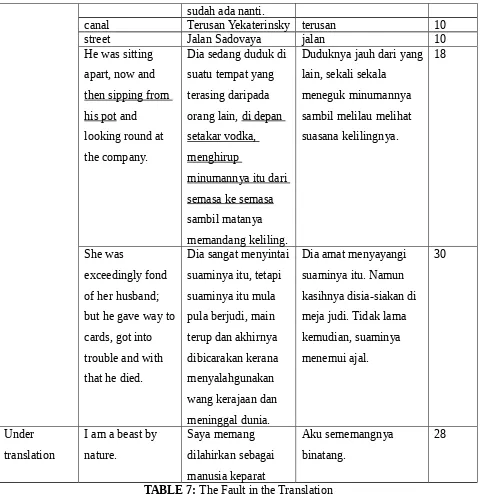TEXTUAL ANALYSIS:
CRIME & PUNISHMENT (BALASAN DOSA)
IZZATI ROZMAN HILMI CHE AHAMAD AMIRUL AKMAL YUSRE
SUFIAN SUHAIMI
University of Sultan Zainal Abidin, Malaysia
TABLE OF CONTENTS
1.1) Brief background on researched novel 1.1.1. Source text
1.1.2. Target text 1.2) Synopsis of the Novel 1.3) Reasons it’s translated
2.0) TEXTUAL ANALYSIS………. ………...……8
2.1) Techniques & Procedures used in Translation
2.2) Explanation on the selected Procedures used in Text Translation 2.2.1. Direct Procedures
2.3) Discussion on the selected 3 procedures with excerpt from the Target text
3.0) REVIEW AND
CONCLUSION………...…20 3.1) Overall assessment of the translation
3.2) Justified opinion on the quality of the translation 3.3) Conclusion
4.0) LIST OF REFERENCES………. ………...…25
1.0) INTRODUCTION
1.1) Brief Background on the Researched Novel
Our textual analysis for this group project is thoroughly based on the classic literature piece that is originally written by Russian author in 1917[ CITATION Fyo171 \l 1033 ]. The authenticity presented in the writing besides the availability of the translated version in Malay language served as the main catalyst for us in analyzing the translated text further in term of the procedures used by the translator in translating the source text[ CITATION Mok941 \l 1033 ]. Below is the background of the source and translated materials used in our textual analysis.
1.1.1) Source text
Title: Crime and Punishment Translator: Fyodor Mikhail Dostoyevsky
Year: 1917
Publisher: Collier & Son
City: New York
1.1.2) Target text
Title: Balasan Dosa
Translator: Mokhtar Ahmad
Year: 1994
Publisher: Dewan Bahasa & Pustaka
City: Kuala Lumpur
1.2) Synopsis of the Novel
changes in the translated version in which all the content were reshuffled into the different organization and this will be discussed further in the Review and Conclusion section.
The major synopsis of this great novel revolved around the mental anguish and dilemmas of deprived man who unconsciously formulates a deadly plan in murdering an old lady because of the poverty. Rodion Raskolnikov is a former student live in the St. Petersburg who has a conflict within himself either to kill or being killed by the poverty itself. He planned to kill an elderly corrupt, unpleasant pawnbroker and money lender named Alyona Ivanovna, arguing that he can perform good deeds using the woman’s money to counterbalance the crime afterwards. By committing the murder, Rascolnikov confirmed his own hypothesis that man in any intricate situation are capable of doing a crime despite of the fears because they even has a right to do the deeds and evidently based the judgment of his action upon the philosophy commended by Napoleon Bonaparte in which “murder is permissible in pursuit of a higher purpose”. In this novel, Raskolnikocv refused all the help from his friend and acquainted himself with a drunker, Semyon Zakharovich Marmeladov in devising the strategy to kill the old lady. Upon serious reflection, he finally murders the women with an axe together with her half-sister, Lizaveta who happen to witness the incident. Manage to hide the crime for a while, he flees unseen and undetected but due to the obsessive worries over the murder, he falls into the serious mental illness coupled by the feverish state. Some unfortunate circumstances came by afterwards in a series of unlucky affairs and he was sentenced to eight years of penal servitude in Siberia. Despite of the struggles he faced upon the crimes committed before, under Sonya’s loving influence he was able to readopt and regenerate back his moral and self-worth after some time. His sister married and live happily while his mother unable to cope with the situation fall sick and dies, leaving Raskolnikov a deeper grief upon the crime he commit.
Due to time constraint, we are able to select only the first three chapters to be included in our textual analysis task. In this chapter, we were introduced to the main protagonist of this novel which is Raskolnikov. Set in the St.Petersburg, Russia in the mid 1860s, the author describe the appearance and physical attributes of the young man in which illustrated as the young, good looking man but dressed shabbily in rags. He lived in a tacky little room and ready to go to the pawnbroker’s house, Alyona Ivanovna. She is indeed a mean old lady but he can’t complain much because she is the resources to get himself a ruble or kopeck of money every time he went there pawning some material since years back. The lady lives with her mentally challenged sister who is very sweet and kind person in an apartment down the street nearby his flat. Along the walk, he continuously fighting with his inner self either to commit the murder or not because he is not so sure whether he is capable of doing it or not despite of the fact that he really should go and will go through the crime sooner or later. His visit to the old lady house was being attend with full suspicion and he thoroughly inspect the house which keep the lady in unease situation. Later he pawns his father’s watch which grants him only a ruble and makes him finally decide his mind to kill the unscrupulous lady. The next day he met with Marmalov, a drunken man whose fate has been crossed by the poverty. From there, two of the man start to devise their strategy to murder the lady but unfortunately Marmalov involved in the accident later in the following days after being trampled by the horse carriage.
1.3) Reasons the Novel was Translated
the condition faced by the Russian in the early 80s. This translated version of the novel may served as a global historical fiction to be included further inside the Malaysia’s canon literature as well as the reading material for those who are interested in the collection of the literature under the gloomy melancholic version.
2.1) Techniques & Procedures Used in Translating the Documents
In translating the document from the source language into the target language, there are several procedures normally being adapted by the translator in order to make the translation process easily conducted. There are many types of translation procedures are among the known one would be direct and oblique procedures proposed by Jean-Paul Vinay & Jean Darbelnet. According to Vinay and Dalbernet’s model of translation procedures, the use of oblique translation procedures in the literary text is presupposed to surpass the direct translation procedures. The table below illustrates the components that exist within both categories.
Table 1: Vinay and Dalbernert’s Model of Translation Procedures
Table 2: Newmark’s Model of Translation Procedures
Table 3: Schreiber’s Model of Translation Procedures
2.2) Explanation on the selected Procedures used in Text Translation
According to the Vinay & Dalbernet’s Translation Model, there are two types of procedures are included which is direct and oblique. According to Oliynyk (2014), direct translation or also called literal translation is applied when “structural and conceptual elements of the source language can be transposed into the target language” resulted into the direct transfer of source language text into a target text [ CITATION Oli14 \l 1033 ]. For instance, “all the birds” that undergo direct translation will became “semua burung” in the Malay language in which all the structural and semantic element from the first language are directly transferred into the target language. There are three categories of direct procedures which are borrowing, calque and literal translation. Below is the definition of each procedure accordingly to several theorists:
Borrowing as defined by the Newmark is the process in which “procedures which is used to overcome a lacuna, usually a metalinguistic one such as a new technical process or an unknown concept”[ CITATION New08 \l 1033 ]. This is however the simplest of all because the main usage of borrowing is to induce the original stylistic effect while incorporate the flavor of the culture presented in the Source language into the target language. The example would be such as menu and déjà vu. Some examples found in our analysis of the target text are:
Zimmerman (pg 7) and Flannel (pg 10).
Calque on the other hand is a special kind of borrowing in which the special expression found in the source language’s expression or structure will be transferred into the literal translation[ CITATION New08 \l 1033 ]. Vinay and Darbelnet later distinguished calque into the two categories namely lexical and structural calque. Lexical calque is the procedure in which while incorporating a new mode of expression into the target language are still respecting the syntactic structure of the source language. For example, “Compliments of the Seasons” will be translated as “Compliments de la saison!”[ CITATION Dai13 \l 1033 ]. The example would be prime minister- > perdana menteri and carburetor- > karburator. Other example found in our analysis of the target text is: landlady -> nyonya rumah (pg 3), cap -> kep (pg 8) and beer ->bir (pg 18).
the Target text. According to Venuti, literal translation is closely referred to the “imitation, an adaptation or a parody” in which not really regard as the true form of translation[ CITATION Ric13 \l 1033 ]. An example found in our analysis of the target text is: I knew it! He muttered in confusion - > “Aku tahu! Katanya merungut secara tak keruan” (pg 7).
To contrast with, oblique procedures on the other hand is the procedures applied when it is impossible for the structural or conceptual element exist in the source text to be directly translated into the target text without adjusting their meaning, grammatical and stylistic elements. For example, the phrase “cows and goats” is translated into “lembu dan kambing”
instead of “lembu-lembu dan kambing-kambing”. There are altogether 4 types of oblique translation which is Modulation, Transposition, Adaptation and Equivalence.
Transposition is the change of one part of speech with another part but still retain the sense of the sentence. Newmark in agreement with Darbelnet proposed that trasnsposition “is a change of the grammatical category in TL in comparison with that in SL” [ CITATION New08 \l 1033 ]. Transposition is largely adapted by the translators when the literal translation can still possibly be used but may not be in coherence with the source text. An example found in our analysis of the target text is: There are chance meetings with strangers that interest us from the first moment, before a word is spoken -> “Yang menarik perhatian kita dari mula-mula lagi ialah pertemuan antara orang-orang yang tidak dikenali yang berlaku secara tiba-tiba walaupun tak sepatah perkataan pun yang dikeluarkan.”(pg 20).
Equivalence in the other hand is the cases where the different stylistic or structural means are employed in the languages that describe the same context and situation which primarily includes idiom, clichés and proverbs. This procedure aim to find the closest likeness of the message in the source language to be further translated into the target language for instance, crying because of pain in French would be Aie!, but upon being translated into the English would become Ouch!. An example found in our analysis of the target text is: My God -> Ya Rabbi (pg 28), hey there -> hoi (pg 7).
2.3) Discussion on the selected 3 Procedures used in Text Translation
Looking at the translation itself, it can be further concluded that all the procedures suggested by Vinay and Dalbernet were used by the translator in translating the source text into the target text. However, upon close study, there are several types of procedures frequently employed by the translator in translating the text which are Equivalence, Adaptation and Calque.
Based on the analysis of the first three chapters, Equivalence procedures are used about 20 times followed by the Adaptation (18 times) and calque (11 times) similar to literal translation (11 times). Other would be Modulation (8 times), Borrowing (5 times) and lastly Transposition (2 times). The whole frequency is summarized into the table below:
TYPES OF PROCEDURES FREQUENCY
Equivalence 20
Adaptation 18
Calque 11
Literal translation 11
Modulation 8
Borrowing 5
Transposition 2
Table 4: Frequency of the Adopted Procedures in the Translation Work
The table below indicates the entire excerpt for each of the translation procedures method evidently found in the target text which is further being categorized accordingly to its own categories.
PROCEDURE
1 Borrowing Zimmerman Zimmerman 7
2 Ikon Ikon 12
3 Mohair Mohair 28
4 Drap-de-dames Drap-de-dames 34
5 Vodka Vodka 40
1 Calque Landlady Nonya rumah 3
2 Haymarket Pasar jerami 6
3 Cap Kep 8
4 Flannel Flanel 10
5 Rouble Rubel 13
6 Kopeck Kopek 14
7 Hay barge Rakit jerami 23
8 Political economy Ekonomi politik 26
9 Young man Orang muda 29
10 Physiology Fisiologi 32
11 Persia Parsi 32
1 Literal Translation His garret was under the roof of a high, five-storied house, and was itu lebih menyerupai sebuah almari daripada
Dari semasa ke semasa dia akan merungut sesuatu…
6
5 I knew it,” he muttered
kep.
once when he had been lost in dreams.
Dia pernah mengira langkahnya itu pada suatu hari semasa dia dihanyutkan oleh mimpinya.
8
9 Everything was very
clean; the floor and the furniture were brightly polished; everything
10 Invariably stood open Sentiasa sahaja terbuka 3
11 some fish, chopped up
small
Ikan dipotong kecil 20
1 Adaptation Garret Tingkat teratas sebuah
rumah
3
2 Attendance Khidmat pengemaan
bilik
4 Den Lubang jerumun 5
5 Plaything! Olok-olok! 5
6 Petersburg’s stench Bau busuk musim panas 5
7 Pot house Kedai arak 6
8 Hideous Penuh cabaran 8
9 Old pancake Kep lama 8
10 Sinking heart Hati yang berat 8
11 Full-skirted coat Kot ketat yang
berkelium dan berkolar tinggi serta keras
18
establishment
13 Counselor in rank Penasihat kehormat 22
High-flown speech Gaya pengucapannya yang bongkak
24
14 a perfect Bedlam Suatu tempat yang
ngeri-segala-galanya hiruk pikuk
32
15 Cyrus of Persia Raja Parsi 32
16 Civil Counselor Anggota Majlis Negeri 33
17 Lie like a beast Terbaring di sana sini
macam anjing kurap
37
18 Poppet Intan payung 39
1 Modulation Hopeless Tidak berguna 3
2 Anxiety of his position Keadaan hidupnya yang
melarat itu
4
3 Given up mengalah 4
4 Nothing that any
landlady could do had a real terror for him.
Hakikatnya, dia tidak takut sedikit pun kepada nyonya rumah itu.
Semasa aku bersiar di jalan raya…
word is spoken. dikenali yang berlaku secara tiba-tiba walaupun tak sepatah perkataan yang pernah dikeluarkan.
1 Equivalence Quite the contrary Tidak begitu 3
2 Verging on
hypochondria
Cemas yang tidak bersebab
4
3 Jack the Giant killer Segala macam hal yang
aneh-aneh
5
4 Airlessness Udara yang pengap 5
5 Hey there! Hoi! 7
6 Please yourself Terserahlah kepada
kamu sendiri
13
7 Goodbye Selamat tinggal 15
8 Good-day Selamat tinggal 15
9 Oh God! Astaga! 15
10 It’s rubbish Tak munasabah 16
11 Phew! Ya rabbi! 17
12 Humming Bersenandung 18
13 Grey beard Janggut putih 18
tarred boots Kasut but hitamnya 19
Stoutly built Berbadan kental 21
14 Funny fellow Sungguh lucu 25
15 Hopelessly Tidak berpeluang
sebesar tuma pun
25
16 …I am not a pig? …saya bukan manusia
tak berguna?
27
17 I am a beast by nature. Saya memang dilahirkan
sebagai manusia keparat.
28
18 Stopped short Membisu seribu bahasa 35
19 Violent excitement Perasaan gundah
gulana
37
20 He-he-he Ha-ha-ha 41
3.0) REVIEW & CONCLUSION
3.1) Overall Assessment
Good translations are often characterized by the ability of the translator in transporting the element of semantic itself in the sense that the translated version is always similar to the source text not only in term of the meaning only, but also the flavor of the language together with the essence of the language itself. In this context, this piece of translation is not really represent the dramatic idea wants to be portrayed by the original author about what’s really happening in the novel itself. The gist of the content are there, but the feeling of being a part of the story are missing as the translator only interested in translating only the meaning but not the whole sentiment and emotion attached to every bits of the textual structures.
Whenever we read the translated version of his, we are always eager to flip in the source text in the English version because of the missing element frequently happen in the translated text. The good things is that the author trying his best to convey each of the semantic element presented in the original text and we can clearly see that every single lines is accompanied by the explanation for the words that is not available in Malay’s cultural context and that served as a good reasons why equivalence procedure scored a lot in the analysis of the text. In order to make it better, the author should also bring the emotion into the translated text.
The meaning are there, but it also should be accompanied by the original stylistic effect to bring the readers into the author’s mind, to help the readers understand the real context of the situation and problem presented in the text, to facilitate the exciting experience while reading the novel and lastly to really portray the sentiment and emotion contained in every characters and how it were passed from one character to another as the whole plot expended to be more complex on its own. Reader’s experience when reading piece of literature materials are highly depends on the first impression when reading the text.
3.2) Justified opinion on the quality of the translated text
The quality of the translated text in our opinion is not as comprehensible as the original text given several mistranslations, under translation, over translation and even misspelling exist in the target text. Besides, some of the translations are too directly follow the language convention of the source language, make it easy to detect the translation process take place into the work itself.
Mistranslation
Mistranslation often being characterized by the mistake in translating the grammatical and the semantic component of the language accordingly to the several linguistic rules that have to be abided in order to convey the meaning accurately. Several mistake made by the translator are summarized further in the table below:
SOURCE TEXT TARGET TEXT RECOMMENDATION PAGE
1 His wife a year he
2 His silent companion looked with positive penuh dingin dan curiga .
18
3 There was another man in the room who looked somewhat like a retired government clerk.
Selain mereka ini, ada lagi seorang yang lain, yang daripada
perawakannya, mungkin seorang pegawai
kerajaan yang sudah berasa.
Masih ada juga seorang lelaki di kamar itu yang perawakannya persis seorang pegawai kerajaan yang sudah bersara.
18
something respectable and like an official about his manner too. orang tua itu adalah seorang yang terhormat dari gerak lakunya yang formal itu.
5 …although it was a working day…
…Walaupun hari itu hari minggu…
…Walaupun hari itu hari bekerja…
6
6 …still keeping her inquiring eyes on his face.
…tetapi matanya yang penuh curiga itu masih terpaku memandang dia.
…masih lagi menatapnya dengan penuh tanda tanya.
11
TABLE 6: Mistranslation in the Target text
Other repetitive mistake often involved the misspelling or simply incorrect representation of the work also happen to frequently occurred in the translated version of the novel. Below is the some example of the misspelling, under translation and over translation happen to occur inside the translated version of Balasan Dosa.
FEATURE SOURCE TEXT TARGET TEXT RECOMMENDATION PAGE
Misspelling Good-day, Alyona Ivanovana.
Pada ketika itu dia cukup sedar bahawa sekali-sekali
fikirannya amat bercelaru …
Pada ketika itu dia cukup sedar bahawa
sekali-Kalau begitu, akan kita bincangkan hal itu nanti ya.
sudah ada nanti.
canal Terusan Yekaterinsky terusan 10
street Jalan Sadovaya jalan 10
He was sitting
Dia sedang duduk di suatu tempat yang terasing daripada orang lain, di depan setakar vodka, meja judi. Tidak lama kemudian, suaminya
TABLE 7: The Fault in the Translation 3.3) Conclusion
one’s language in transferring process may always result in the miscommunication of the info to the audience. This study also highlights the importance of equivalence procedure in translating the foreign language into one’s native language as the similarity in the same concept in the equal context not always correspondingly exist in both language and hence to find the naturally closest equivalent is the best way after all. Last but not least, it is also best argued that too much literal translation in the creative work is not that significantly contribute to the pleasant reading experience especially to local reader and therefore we want to suggest that modulation and transposition process are applied more into the translating this kind of literature masterpiece in the future.
Bibliography
Ahmad, M. (1994). Balasan Dosa. Kuala Lumpur: Dewan Bahasa dan Pustaka.
Dostoyevsky, F. M. (1917). Crime and Punishment. New York: Collier & Son.
Newmark, P. (2008). A Textbook of Translation. Harlow: Pearson Education Limited.
Schiaffino, R., & Zearo, F. (2013). Translation Quality Measurement in Practice. 46thATA Conference. Seattle: Aliquantum.
Schjoldager, A. (2008). Understanding Translation. Wales: Academica.
Shakernia, S. (2014). Study of Nida’s (formal and dynamic equivalence) and Newmark’s (semantic and communicative translation) translating theories on two short stories. Merit Research Journal of Education and Review , 2-7.
Shuttleworth, M., & Cowie, M. (2014). Dictionary of Translation Studies. California: Routledge.
Šidiškytė, D., & Tamulaitienė, D. (2013). The Contrastive Analysis of the Translation of English Film Titles into Lithuanian and Russian. St.Petersburg: Kalbu Studijos.

